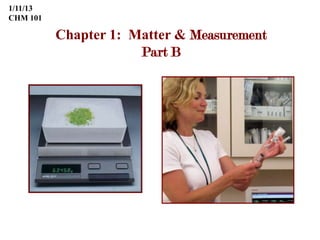
Ch. 1 lecture b
- 1. 1/11/13 CHM 101 Chapter 1: Matter & Measurement Part B
- 2. Scientific Notation Scientific notation is used to write very large or very small numbers. A number in scientific notation contains a coefficient and a power of 10. coefficient power of ten coefficient power of ten 1.5 x 102 7.35 x 10-4 To write a number in scientific notation, the decimal point is moved so it will lie after the first digit. All significant figures are written. 52 000. = 5.2000 x 10 4 0.00378 = 3.78 x 10-3 4 spaces left 3 spaces right (use negative exponent) (use positive exponent) See Section 1.6 in your text for a detailed treatment of scientific notation (ASK FOR HELP!)
- 3. Units of Measurement You MUST know the prefixes below and be able to use them as conversion factors. Used to represent large quantities Used to represent small quantities
- 4. Equalities An equality states the same measurement in two different units, or in the same unit with two different prefixes. 1 km = 1 x 103 m 1 cm = 1 x 10-2 1 mg = 1 x 10-3 g 1 m = 1 x 10-3 km m 1 x 103 mg = 1 g 1 m = 100 cm 1000 m = 1 km 1000 mg = 1 g Equalities are also written for relationships between units of the metric system, U.S. units, or between metric and U.S. units. 1 in. = 2.54 cm 454 g = 1 lb
- 5. Conversion Factors A conversion factor is a fraction obtained from an equality. Equality: 1 in. = 2.54 cm The conversion factor is written as a ratio with a numerator and denominator. It can be inverted to give two conversion factors for every equality. 1 in. 2.54 cm or 2.54 cm 1 in. Equality: 1 m = 1 x 106 mm 1m 1×10 6 μm or 1×10 6 μm 1m
- 6. Factor-Label Method for Conversions How many minutes are 2.5 hours? Given unit = 2.5 hr Needed unit = min Unit Plan = hr min Setup problem to cancel hours (hr). Given Conversion Needed unit factor unit 2.5 hr x 60 min = 150 min (2 SF) 1 hr **Always write out the conversion factor with units. Cross through the units that cancel and make sure you end with the desired unit.
- 7. Factor-Label Method for Conversions How many minutes are 2.5 hours? Given unit = 2.5 hr Needed unit = min Unit Plan = hr min Setup problem to cancel hours (hr). Given Conversion Needed unit factor unit 2.5 hr x 60 min = 150 min (2 SF) 1 hr **Always write out the conversion factor with units. Cross through the units that cancel and make sure you end with the desired unit.
- 8. Units & Conversion Factors The diameter of an average sodium atom is 186 nm. What is the diameter in cm? In inches? A man weighs 83.95 kg. What is his weight in pounds? Do you know how to enter scientific notation on your calculator?
- 9. Record the temperatures on the thermometers below as accurately as possible. 28°C 28°C 27°C 27°C 26°C 26°C 25°C 25°C °C °C Always estimate one digit beyond the last marking.
- 10. Now Let’s Practice Measuring and Converting Units using the Factor-Label Method
